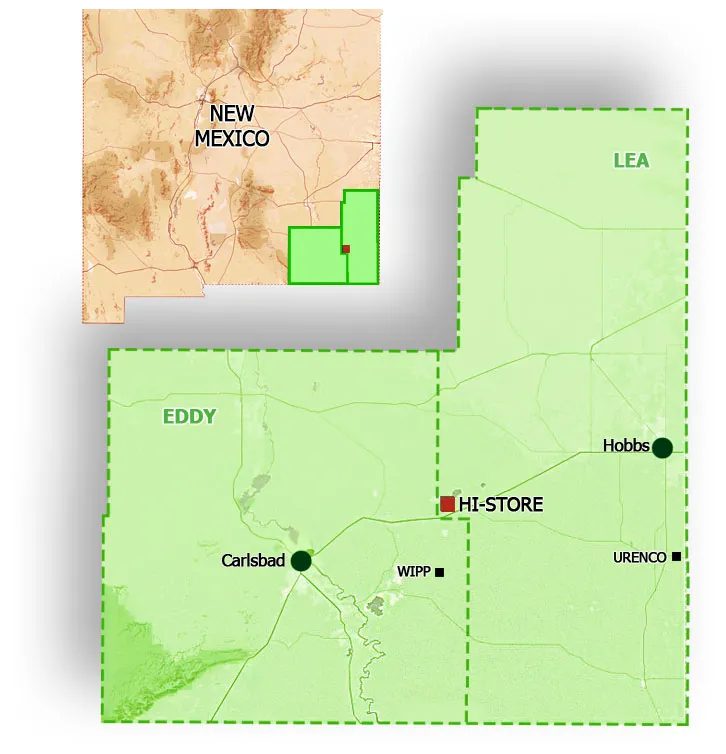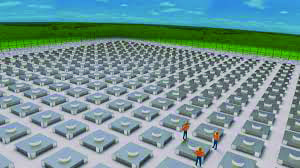NRC Issues License for Holtec’s New Mexico Consolidated Spent Nuclear Fuel Storage Facility

The Nuclear Regulatory Commission (NRC) has granted Holtec International a license to build and operate a consolidated interim storage facility (CISF) for spent nuclear fuel in southeastern New Mexico, despite the state's opposition.
Granted on May 9 after an eight-year process, the NRC's license allows Holtec to receive, possess, transfer, and store" 500 canisters holding about 8,680 metric tons of commercial spent nuclear fuel for 40 years at the HI-STORE CISF. Holtec plans to build the HI-STORE CISF in Lea County and Eddy County, New Mexico, on land provided by regional economic development authority Eddy Lea Energy Alliance (ELEA).
 Location of the proposed HI-STORE Consolidated Interim Storage Facility. Courtesy: Holtec
Location of the proposed HI-STORE Consolidated Interim Storage Facility. Courtesy: HoltecHoltec, one of the largest spent fuel vendors in the U.S., lauded the NRC's license for the initial phase of construction of the CISF, underscoring that the license is the first in the nation for a below-ground storage system for CISF. The HI-STORE CISF will utilize Holtec's licensed HI-STORM UMAX, an underground dry storage system engineered and sized to hold all currently licensed dry spent fuel storage canisters throughout the U.S.," the company said.
UMAX' stores fuel below-ground in impregnable bunkers making it safe from threats of extreme environmental phenomena or acts of human mendacity such as a crashing aircraft," the company says. The subterranean HI-STORM UMAX storage system is so environmentally unobtrusive that all industrial activities such as fracking, drilling, and potash mining in the area can continue without obstruction and, as stated in the final environmental impact study, construction of the proposed CISF would not have an effect on oil and gas operations regardless of drilling method," it said.
While the initial application to the NRC is for 500 canisters, Holtec is planning future amendments" for additional canisters of up to 10,000 canisters in 19 phases, each expansion phase which would require a license amendment with additional NRC safety and environmental reviews. The U.S. currently has more than 80,000 metric tons of used nuclear fuel in storage and more is being generated every day at a rate of 2,000 metric-tons per year," it noted.
 Artist's rendering of the HI-STORE CIS Storage facility. Courtesy: HoltecThe Long Route to Consolidated Interim Storage
Artist's rendering of the HI-STORE CIS Storage facility. Courtesy: HoltecThe Long Route to Consolidated Interim StorageIn light of a long-standing impasse on the U.S. federal government's ability to deal with spent nuclear fuel, Holtec's license triumph is notable.
While the 1982 Nuclear Waste Policy Act (NWPA) obligated the Department of Energy (DOE) to begin permanent disposal of highly radioactive SNF from the nation's reactor operators, SNF has remained safely but indefinitely stranded on 76 operating and shutdown plant sites in 35 states where it was generated for 25 years.
And it has been expensive. According to the Nuclear Waste Strategy Coalition (NWSC), an ad hoc group of public and private sector members that are collaborating to spur federal action on the issue, the intended but unfulfilled quid pro quo-commercial nuclear waste disposal in return for the billions of dollars in fees collected by nuclear-generating utilities" has come at deep costs to taxpayers. Since 1983, more than $21.5 billion has been collected from electric customers for the federal Nuclear Waste Fund, which has accumulated more than $31 billion in interest and carries an approximate $46 billion balance (while continuing to accumulate interest at approximately $1.7 billion per year)," the group noted in January.
In addition, U.S. taxpayers have paid more than $10 billion thus far and are conservatively estimated to be required to pay an additional $31 billion in damages due to the federal government's failure to meet the 1998 deadline to begin removing SNF," the group said. Simply, it is past time for the federal government to honor its part of the agreement with meaningful action."
As POWER has reported in-depth, after decades of near-silence, the DOE has begun to act. In November 2021, it formally revived a consent-based siting process for nuclear waste, which the Obama administration's Blue Ribbon Commission recommended in 2012. The agency has since begun implementing a consent-based siting process to site one or more federal CISFs as a near-term alternative to a permanent repository. Driven by disposition uncertainties and concerns about future advanced nuclear reactor fuel supplies, it has also begun to explore SNF reprocessing.
Still, given the long-standing political impasse on federal action, efforts to build CISF facilities have been more recently headed by two private companies: New Jersey-based energy industry equipment supplier Holtec, which submitted its application to the NRC for the HI-STORE CISF in March 2017, and Interim Storage Partners (ISP), a joint venture between Waste Control Specialists (WCS) and Orano's U.S.-based arm.
While WCS initially proposed to build an interim SNF storage facility as early as 2022 at its 14,000-acre site near Andrews, Texas, it asked the NRC to temporarily suspend review activities in April 2017, citing a magnitude of financial burdens"-stemming from a $7.5 million review cost-that made the pursuit of licensing unsupportable. In June 2018, backed by Orano, ISP submitted a revised license application to the NRC. In September 2021, the NRC granted that license, allowing ISP to build and operate a CISF.
ISP, however, has not yet initiated construction. During a webinar hosted by the American Nuclear Society in April, Sven Bader, technical consultant for Orano Federal Services, declined to comment on the project's status given that it is currently in litigation."
New Mexico Vows State Hurdles, Legal RecourseA major challenge faced by both Holtec and ISP has been contention from states in which their CISFs have been proposed. New Mexico, notably has challenged the legality of the NRC's proceedings. In March, the state went further and enacted SB-53, a law that prohibits the issuance or certification of state permits, contracts, leases, or licenses for the construction or operation of any spent nuclear fuel or high-level waste disposal facility.
The NRC in a statement on Tuesday said its review of the Holtec license application included a technical safety and security review, an environmental impact review and adjudication before an Atomic Safety and Licensing Board. A safety evaluation report, documenting the technical review, is being issued along with the license. A final environmental impact statement was published last July and supplemented in October," it said.
In addition, an environmental study included extensive public input during its development and during the comment phase." That adjudication resolved contentions filed by several local and national petitioners," the NRC said.
Following the NRC's decision, however, New Mexico Governor Michelle Lujan Grisham and Attorney General Raul Torrez in a joint statement suggested their fight to protect New Mexico from becoming a nuclear dumping ground" was not over. SB-53 will impose new, more robust state licensing requirements for this project before any construction may begin," the state leaders predicted. In the meantime, we are evaluating available legal recourse and will take any action necessary to make sure that ground is never broken on this interim' facility in New Mexico."
-Sonal Patelis a POWER senior associate editor (@sonalcpatel,@POWERmagazine).
The post NRC Issues License for Holtec's New Mexico Consolidated Spent Nuclear Fuel Storage Facility appeared first on POWER Magazine.